Hispanic Stories on the Opera Stage

Opera has always been a meeting ground of cultures. Though it began in Italy more than 400 years ago, the art form has grown by including stories, music, and artists from around the world. This Hispanic Heritage Month, we celebrate the vibrant influence of Hispanic culture on opera—a tradition that continues to shape the way audiences experience the art form today.
Heroes and Legends: Zorro

Few characters have captured imagination across cultures quite like Zorro, the masked vigilante of Spanish-colonial California. His adventures of daring sword fights and secret identities are perfect for a grand stage. In fact, they made their way into the operatic world through Cuban American composer Héctor Armienta’s opera Zorro.
Blending traditional operatic style with mariachi and Spanish musical influences, Armienta’s Zorro brings the hero to life in a distinctly Hispanic voice. Companies like Fort Worth Opera and Opera Santa Barbara have staged the work in recent years, showcasing how a figure born from Hispanic history and storytelling can continue to inspire new works of art. It’s a reminder that opera is not only about retelling the classics—it’s about embracing new stories that reflect the heritage of many communities.
A Journey Through the Amazon: Florencia en el Amazonas

In 2012, Opera Colorado produced Florencia en el Amazonas by Mexican composer Daniel Catán—the first Spanish-language opera commissioned by major American opera houses. Inspired by the magical realism of Gabriel García Márquez, the opera tells the story of a world-famous soprano returning to her homeland by riverboat, searching for her long-lost love as the Amazon itself seems to breathe with mystery and life.
When Opera Colorado staged Florencia, audiences were swept into a world of lush orchestration and Latin American storytelling. Its blend of universal themes—love, loss, and longing—with distinctly Hispanic cultural expression offered Denver audiences an experience unlike any other.
Other Stories that Sing

Florencia is just one of many works that bring Hispanic heritage into opera. Bizet’s Carmen, though written by a Frenchman, transported audiences to Seville with its Spanish setting and rhythms. Osvaldo Golijov’s Ainadamar tells the haunting story of Spanish poet Federico García Lorca through the sounds of flamenco. Robert Xavier Rodríguez’s Frida captures the fierce, colorful spirit of painter Frida Kahlo, blending operatic drama with Mexican folk traditions.
These operas expand the repertoire with stories that are both distinctly Hispanic and universally human, adding richness to the art form and offering audiences new ways to see themselves reflected on stage.
Voices that Carry the Tradition

It is not only the stories themselves that matter—it is also the artists who bring them to life. Singers like Juan Diego Flórez, Ailyn Pérez, Cecilia López, and Arturo Chacón-Cruz have carried Hispanic heritage onto the world’s great stages. Behind the scenes, Hispanic conductors, directors, and composers continue to shape opera’s future. Their artistry ensures that opera remains alive, evolving, and reflective of the diverse world we live in.
Opera is at its best when it embraces many voices. Hispanic heritage has given the art form unforgettable stories, music, and artists. As we celebrate this month, we are reminded that opera is not just a European tradition—it is a global one, enriched by the beauty and diversity of Hispanic culture.


